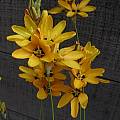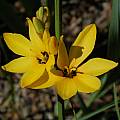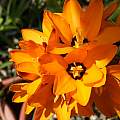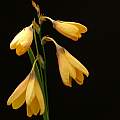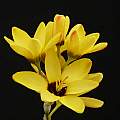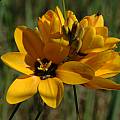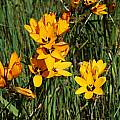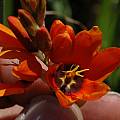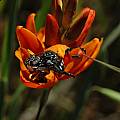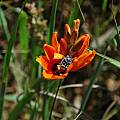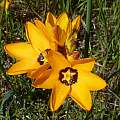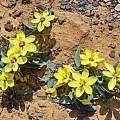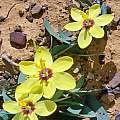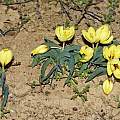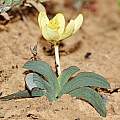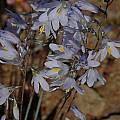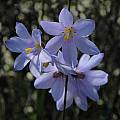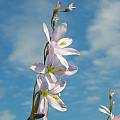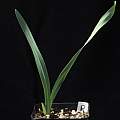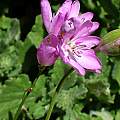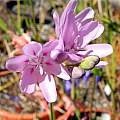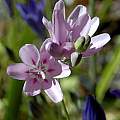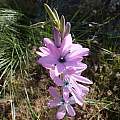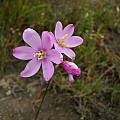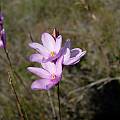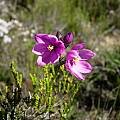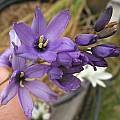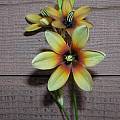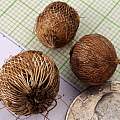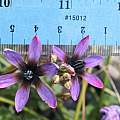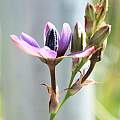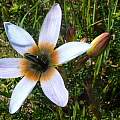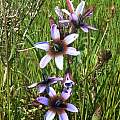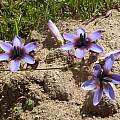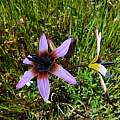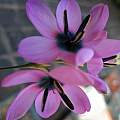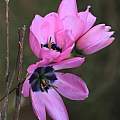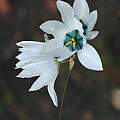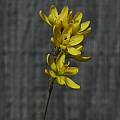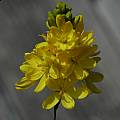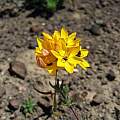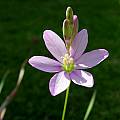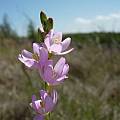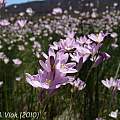Ixia is a genus in the Iridaceae family with 100 species mainly from the western, southwestern, and southern winter-rainfall areas of the Northern, Western and Eastern Cape Provinces of South Africa. Information and photographs illustrating Ixia m-o can be found on this page.
Ixia maculata L. is found on granite and sandstone flats and slopes in the northwest and southwest Cape. It has orange to yellow flowers with a dark central ring and star-like center. Height range: 20-50 cm. It grows well in the ground in Northern California where it blooms in March or April. The first three photos of garden plants are by Mary Sue Ittner. The fourth is by Michael Mace. The last two photos are from Nick de Rothschild who wondered if the pendulous plant was Ixia maculata or not. The last photo was added of an upright form for comparison. There was no conclusion although a number of people mentioned that ixias that are rained on often fall over.
The first five photos taken below by Mary Sue Ittner and Bob Rutemoeller show plants in bloom on the way to Darling, West Coast, September 2006 in two different colored populations. The last group was being pollinated by beetles. The last photo was taken by Cameron McMaster also near Darling September 2011.
Ixia macrocarpa Goldblatt & J.C.Manning is known from a single population near Loeriesfontein, Northern Cape where it grows on stony, shale flats in fine-grained clay soils. It was discovered in 2014. It has falcate leaves and long-tubed pale yellow flowers with dark markings. It is one of only two acaulescent species. Height range: 3-5 cm. Photos from iNaturalist were taken by Richard Adcock and shared under a CC BY-NC license.
Ixia marginifolia G.J.Lewis is found on stony slopes in renosterveld in the Roggeveld. It is similar to Ixia rapunculoides with pale blue to mauve flowers, but has well exserted filaments. Plant height: about 75 cm. The first three photographs were taken near Middlepos by Bob Rutemoeller and Mary Sue Ittner September 2006. The fourth photo was taken by Alan Horstmann. The fifth photo of a second season seedling from Silverhill Seeds grown by M. Gastil-Buhl shows the leaves thickened at the margin and midrib.
Ixia metelerkampiae L.Bolus grows on sandstone mountain slopes in the southwest Cape and blooms from November to December. It grows to 70 cm high and has pale pink to bluish mauve or purplish lilac flowers with a minute maroon central star sometimes outlined with white and small red marks at the base of each segment. Photos by Alan Horstmann, Mary Sue Ittner, and Rod Saunders.
Ixia micrandra Baker grows on rocky sandstone slopes and flats in the western and southern Cape. It has a short spike of 2 to 6 white to pink or mauve flowers with short exserted stamens and spreading tepals. The anthers are oblong. Height: 25-50 cm. Photos taken by Cameron McMaster in Bredasdorp, Napier, and Drayton in the Overberg.
Ixia monadelpha D.Delaroche has flowers that are violet, mauve, pink, apricot or white, rarely yellow, all with a contrasting center which is outlined with a circle of still another color. It flowers in spring and is found on wet sandy flats in the southwestern Cape. Height range: 15-40 cm. The first photo from Bob Rutemoeller is looking a little less than perfect after a fair amount of spring rain. The second photo by Mary Sue Ittner is of a mustard colored one. Photos 3-5 by M. Gastil-Buhl show corms on a 1 mm grid, grown by Jim Duggan, who recommends part shade, and a flower from those same corms, grown in full sun. The flowers opened successively up a 10 inch (26 cm) spike, spanning over a week in April, opening each morning and closing at dusk. The leaves began to brown before the flowers bloomed.
Photos below were taken by Cameron McMaster near Darling in the Western Cape September, 2011.
Ixia mostertii M.P.de Vos is known from three locations in the Upper Breede River Valley between Wolseley and Worcester. None of the locations was protected as of 2005, and the species was considered endangered. Flowers vary from white to deep pink, with a dark blue, purple, or blue-green center. Height: to 45 cm. More information is available here. The first photo is from Gordon Summerfield. The next two photos from iNaturalist were taken by Patrick Lane near Worcester in September and shared under a CC BY-NC license.
Ixia odorata Ker Gawl. grows on sandstone and granite slopes in the northwest and southwest Cape. It has small yellow or cream fragrant flowers. Height range: 30-60 cm tall. The first two photos by Mary Sue Ittner. The last from Rod Saunders and Silverhill seeds.
Ixia orientalis L.Bolus grows on flats and slopes in winter and summer rainfall areas and flowers in spring. It is the only species that extends into the Eastern Cape. Leaves are narrow and flowers are cream to mauve-pink and filaments are exserted. Height range: 25-70 cm. The first two photos from Cameron McMaster were taken in the Eastern Cape. The second one was taken at Gaika's Kop. The third photo from the book Plants of the Klein Karoo courtesy of Jan and Anne Lise Schutte-Vlok. It is abundant in the Little Karoo.
